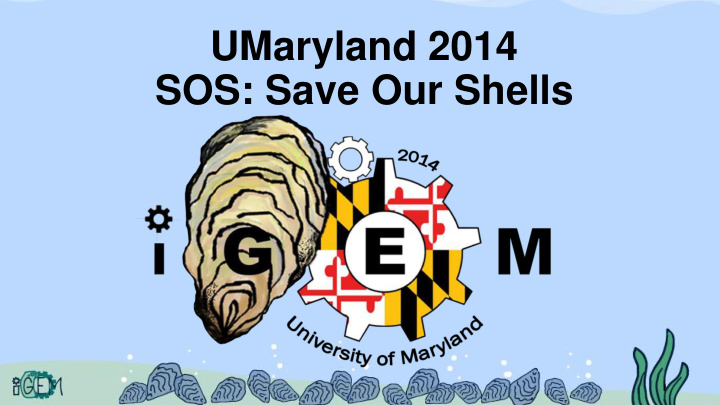



UMaryland 2014 SOS: Save Our Shells
Chesapeake Bay National landmark: largest estuary in U.S. Maryland’s most important natural resource Billions of dollars in aquaculture annually However… http://www.cbf.org/image/area---about-cbf/partnerships/scenic_pleasure-house-point_Jamie-Betts-Trust-for-Public-Land_695x352.jpg
Chesapeake Bay Issues Sewage Fertilizer runoff Industrial pollutants How can we clean up the Chesapeake through synthetic biology? http://www.ecologicalhope.org/wp-content/uploads/2008/09/sewage-pours-into-chesapeake-bay-watershed.jpg http://organic-center.org/hot-science/fertilizer-runoff-leads-to-larger-chesapeake-bay-dead-zone/ http://gogreen.umaryland.edu/files/2012/09/6.-toxic-water-slideshow.jpg
Oysters: Treasure of the Chesapeake Natural filter feeders Largest filtration system in the Chesapeake Bay Oysters have their own issues! Over-harvesting Disease http://upload.wikimedia.org/wikipedia/commons/b/b0/Crassostrea_gigas_p1040848.jpg
Perkinsus marinus causes Dermo Disease Unicellular protist Infests oyster hemocytes Resists oyster immune system Growth inside oyster eventually leads to oyster death from Smithsonian Environmental Research Center
Infection Pathway Oyster hemocyte uses galactose binding proteins called galectins to recognize carbohydrates Galectins are found on the oyster’s surface Binding leads to signaling pathway resulting in phagocytosis P. marinus recognized by oyster galectin CvGal1 P. marinus produces superoxide dismutase All possible avenues for intervention!
Adapting Oyster Recognition System as a Biosensor Crasseoterra virginica Galectin 1 (CvGal1): Galectin on hemocyte of Eastern Oyster Four domain galectin CvGal1 binds a complex carbohydrate on the surface of P. marinus Can we engineer a galectin to make a biosensor for detecting P. marinus?
Who Cares? Filter Feeding! Crassotrea virginica, the Eastern Oyster Keystone species Vital to the livelihood of the region http://sercblog.si.edu/?p=2842 from National Oceanic and Atmospheric Administration
Human Practices and Policy Environment Economics Policy UMD iGEM
Environment: How is the Oyster Problem being Addressed? Collection of suitable shells Cleaning and gardening of oysters Actively participated in restoration efforts We developed a complementary approach that targets the problem
Economy: How is Oyster Farming and Aquaculture Affected? Learning about the applications of our Choptank Oyster Farm along the Chesapeake Bay device with Mr. Kevin McClarren We learned that a quicker assay is a necessity in addressing problems faced by oyster farmers Incorporated this insight into our project design and future goals
Policy: What Measures are being taken to Control Oyster Infections? Mr. Chris Dungan explaining sample collection Top: Visualization of Perkinsus sp. with RFTM+Lugol’s Iodine Bottom: Visualization with fluorescent antibody-labeling Practiced current techniques to learn about existing detection methods Learned about current regulations in place to address the problem A rapid assay would revolutionize the field from Reece and Dungan(2005) Perkinsus sp. Infections of Marine Molluscs. AFS/FHS Blue Book diagnostic manual . 6, 8
If the Problem is Known and the Solutions are Known… What is a Biosensor? 140 How do you feel about genetic engineering? 120 a device that measures biological 120 Number of Students Number of Students parameters such as temperature or pressure 100 100 Strongly Oppose an instrument that has a biological 80 80 component and measures physical Oppose 60 or chemical parameters Neutral 60 an organ that measures biological 40 Support phenomenon 40 20 Strongly Support an organism that has the ability to 0 20 Responses sense other organisms 0 Responses Compared and contrasted different perspectives Environmental- broad, concerned with general health of the bay, population-oriented Economy- need fast and cheap tests Policy- specific approach, try to address root problem Extended conversation to the community Promoted synthetic biology research and iGEM
Designing a Biosensor Put a galectin on the surface of E. coli to use the cell as a biosensor Desired characteristics of biosensor Must be localized to outer cell membrane (sensing whole eukaryote) Must be non-toxic to the E. coli Must bind specifically to P. marinus Can we utilize previously designed Ruiz N, Kahne D, Silhavy TJ. Advances in understanding bacterial outer-membrane biogenesis. Nat Rev Microbiol. 2006;4(1):57-66. BioBricks?
BtGal1 — A Simple Galectin CvGal1 is large, largely uncharacterized BtGal1 is a 2-domain galectin from Bos taurus (cow) Small, well-characterized protein as model system How to anchor protein in cell membrane? Kallberg M, Wang H, et al. Template-based protein structure modeling using the RaptorX web server. Nat Protoc. 2012:7(8):1511-22.
BioBrick for Sensor Localization OmpA (BBa_K103006) Transmembrane domain with unstructured linker Displays proteins on outer membrane Displays target protein from the C-terminus of OmpA Kallberg M, Wang H, et al. Template-based protein structure modeling using the RaptorX web server. Nat Protoc. 2012:7(8):1511-22.
BioBrick for Pathogen Binding BtGal1 (BBa_K1489000) Design a gBlock (IDT) with an optimal sequence based on structure and chemical properties His-Tag PROJECT GOAL: Combine an existing BioBrick (OmpA) with a newly constructed BioBrick (BtGal1) to generate a functional P. marinus biosensor
OmpA was Improved for pSB1C3 OmpA was transferred from pSB1A2 to pSB1C3 via RE cloning (BBa_K1489002) (Top) OmpA previously designed with SacI site at 3’ end Mutagenize SacI site into KasI site (BBa_K1489003) (Bottom)
BtGal1 BioBricks Successfully Cloned BtGal1 gBlock (IDT) was cloned into pSB1C3 With OmpA (BBa_K1489004) and without OmpA (BBa_1489000) Under control of pBAD promoter + RBS Addition of His-Tag
Expression Tests BtGal1, OmpA-BtGal1 cultures induced with arabinose (0.2%, 22 hours) SDS-PAGE Western blot (Anti-His6) Protein is expressed
BtGal1 Fluorescence Binding Assay BtGal1 induced (0.2% arabinose, 6 hours) Lysate purified via Cobalt column Fluorescence binding assay w/ lactose Confirms that BtGal1 works
Future Applications- Microfluidics Microfluidic sorting device Separation based on size of organism complex Easy to use and detect a fluorescent signal No additional cloning necessary Collect environment sample into isolated environment
Future Applications-Signaling Cascade Two integrated approaches CPX stress induced signal Split GFP proximity induced signal Reliance on downstream activation Possibility to add additional responses into cascade
Conclusions Identified a need for a real time biosensor that could positively impact our surrounding ecosystem Conducted extensive background research on the affected community, as well as those involved directly with oyster farming and preservation Created 4 BioBrick constructs, including a characterized and expressed chimera protein to bind to P. marinus Developed multiple approaches for implementing our device into a greater system
Acknowledgements: • Dr. William Bentley, Dr. John Buchner, Dr. Ben Woodard, John Wilhelm III, Dr. Gerardo Vasta, Dr. Osnat Herzberg, Chris Dungan, Dr. Angela Jones, Navadeep Boruah, UMD Cell Biology and Molecular Genetics, Kahn Lab, Bentley Lab, and Eisenstein Lab
http://fc01.deviantart.net/fs24/f/2007/340/8/c/The_world_is_your_oyster_by_mad1dave.jpg
Recommend
More recommend